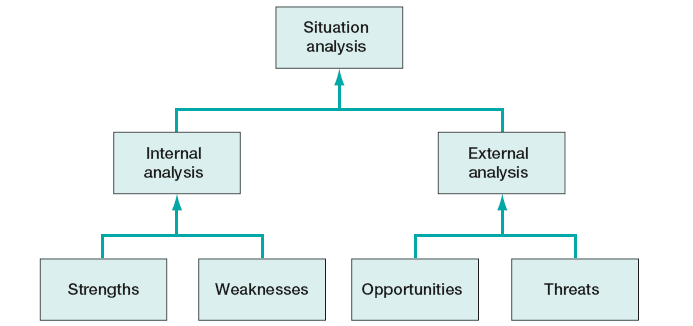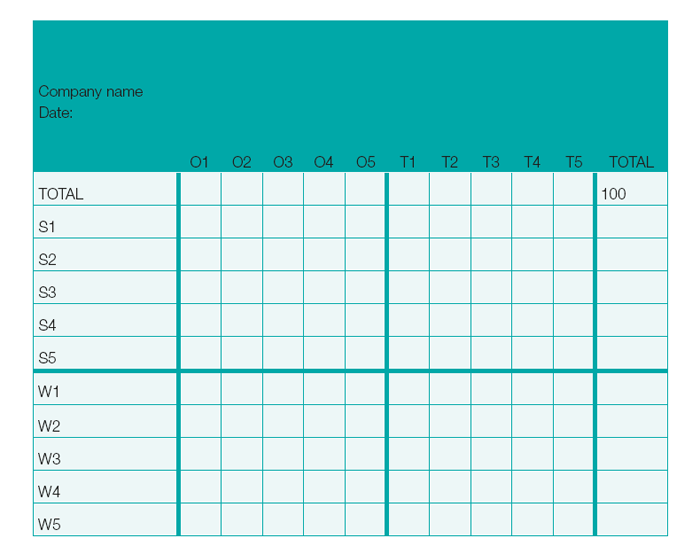

Any company undertaking strategic planning must at some point assess its strengths and weaknesses. When combined with an inventory of opportunities and threats within or beyond the company’s environment, the company is making a so-called SWOT analysis (or TOWS analysis), establishing its current position in the light of its strengths, weaknesses, opportunities and threats (Figure 14.1)

Figure 14.1 Situation analysis
Source: after Weihrich (1982)
The SWOT analysis provides helpful information for matching resources and capabilities to the competitive environment in which the organisation operates. The model can be used as an instrument for devising and selecting strategy, and is equally applicable in any decision-making situation, provided the desired objective has been clearly defined.
The first step in carrying out a SWOT analysis is to identify the company’s strengths, weaknesses, opportunities and threats. A scan of the internal and external environments is therefore an important part of the process. Strengths and weaknesses are internal factors. They are the skills and assets (or lack of them) that are intrinsic to the company and which add to or detract from the value of the company, relative to competitive forces. Opportunities and threats, however, are external factors: they are not created by the company, but emerge due to the activity of competitors, and changes in the market dynamics.
Strengths and weaknesses can be measured with the help of an internal or external audit, e.g. through benchmarking (see also Chapter 18). Opportunities and threats occur because of external macro-environmental forces such as demographic, economic, technological, political, legal, social and cultural dynamics, as well as external industry-specific environmental forces such as customers, competitors, distribution channels and suppliers.
After the internal and external analysis, the results can be placed in a so-called confrontation matrix (Figure 14.2). In this matrix, the strengths, weaknesses, opportunities and threats can be listed and combined. Then points can be given to each of the combinations: the more important they are, the more points are awarded. This confrontation leads to an identification of the organisation’s primary, and often urgent, strategic issues.

Figure 14.2 The confrontation matrix
Source: adapted from Weihrich (1982)
The next step is to evaluate the actions the company has to take based on its SWOT analysis. Should the company focus on using its strengths to capitalise on opportunities, or acquire strengths in order to capture opportunities? Moreover, should the company try actively to minimise weaknesses and avoid threats? (See Figure 14.3.)
‘SO’ and ‘WT’ strategies are straightforward. A company should do what it is good at when the opportunity arises, and avoid businesses for which it does not have the competencies. Less obvious and much more risky are ‘WO’ strategies. When a company decides to take on an opportunity despite not having the required strengths, it must:
In essence, companies that use ‘ST’ strategies will ‘buy or bust’ their way out of trouble. This happens when big players fend off smaller ones by means of expensive price wars, insurmountable marketing budgets or multiple channel promotions. Some companies use scenario planning (Chapter 12) to try to anticipate and thus be prepared for this type of future threat.
| 10 | Develop an action plan to implement the SWOT strategy. |
| 11 | Assign responsibilities and budgets. |
| 12 | Monitor progress. |
| 13 | Start the review process from the beginning. |
A SWOT analysis is a valuable self-assessment tool for management. The elements – strengths, weaknesses, opportunities and threats – appear deceptively simple, but, in fact, deciding what the strengths and weaknesses of a company are, as well as assessing the impact and probability of the opportunities and threats in the external environment, is far more complex than it looks at first sight. Furthermore, beyond classification of the SWOT elements, the model offers no assistance with the tricky task of translating the findings into strategic alternatives. The inherent risk of making incorrect assumptions when assessing the SWOT elements often causes management to dither when it comes to choosing between various strategic alternatives, frequently resulting in unnecessary and/or undesirable delays.
Abell, D.F. and Hammond, J.S. (1979) Strategic Marketing Planning: Problems and Analytical Approaches. Prentice Hall.
Armstrong, J.S. (1982) ‘The value of formal planning for strategic decisions’. Strategic Management Journal 3, 197–211.
Hill, T. and Westbrook, R. (1997) ‘SWOT analysis: It’s time for a product recall’. Long Range Planning 30(1), 46–52.
Menon, A., Bharadwaj S.G., Adidam, P.T. and Edison, S.W. (1999) ‘Antecedents and consequences of marketing strategy making. A model and a test’. Journal of Marketing 63(2), 18–40.
Weihrich, H. (1982) ‘The TOWS matrix, a tool for situational analysis’. Long Range Planning 15(2), 54–66.